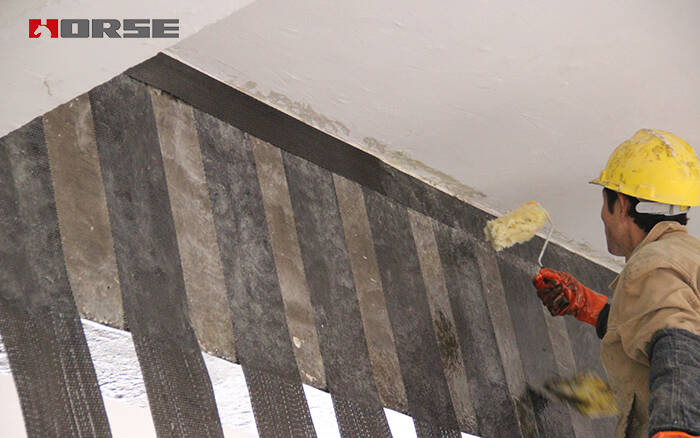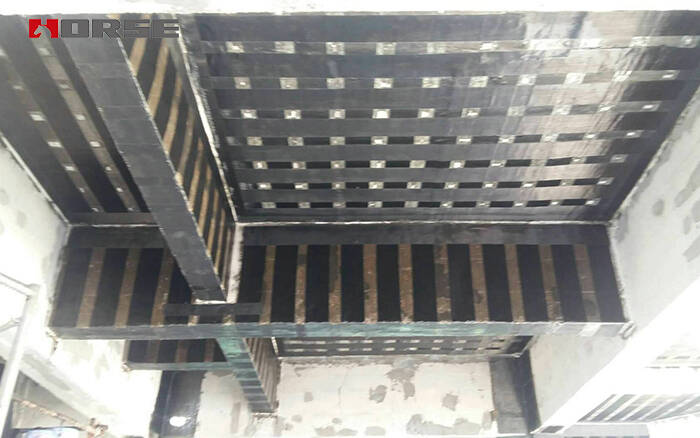Solutions
Horse Construction offers full range of structural strengthening materials with technical supports, documentation supports, products supports, project supports.
Design And Application Examples Of Carbon Fiber Sheet Reinforcement

Project Overview
The seismic fortification intensity of a reconstruction project is: 6 degrees; the frame seismic level is four, and the building has three floors above ground and one underground. The height of the building is 14.07m. The original architectural design function is an ordinary townhouse. After the main body is completed, before it is officially put into use, the owner will change its use function and turn it into a resort hotel according to market demand. This change requires the opening of the partition walls of the original townhouses, the addition of building partitions, elevator rooms, etc. The space use function, layout and load of buildings have undergone major changes. According to the new building layout, PKPM software is used to load new loads on the original structure model, and the original structure design is recalculated. The calculation results show that after the building's use function is changed, the original structural component columns basically meet the requirements. All layers of the original design appeared under the action of the new load. Some beam end supports and the bottom span of the beam were insufficient in flexural bearing capacity, some beams were insufficient in shear bearing capacity, and the original reinforcement of local plates did not meet the current calculation requirements. In order to ensure that the building meets the new requirements, the beam and slab components with insufficient bearing capacity must be reinforced.
Reinforcement plan
Analyze and determine the calculation and analysis of beams and plates with insufficient bearing capacity. The results show that if the carbon fiber reinforcement method is used, the load-bearing capacity of the normal section of most beams will not exceed 40% after strengthening, and the load-bearing capacity of the oblique section and the slab can meet the requirements of the load-bearing capacity after flexural strengthening. Due to the owner's requirement that the reinforcement construction processing time should be as short as possible, so that the building can be put into use as soon as possible to receive the greatest economic benefits. Therefore, this project mainly uses carbon fiber sheets to strengthen beams and slabs. Part of the beams whose normal section bearing capacity has been increased by more than 40% adopts the reinforcement scheme supplemented by the enlarged section method.
Introduction to Reinforcement Design
According to Article 4.3.2 of "Technical Specification for Carbon Fiber Sheet Reinforced Concrete Structure" CECS146:2007. The tensile surface of the rectangular cross-section flexural member adopts the formula for calculating the flexural bearing capacity of the normal cross section when the carbon fiber sheet is bonded to strengthen the bending. Article 4.3.3: For T-shaped flexural members with flanges located in the compression zone, carbon fiber sheets shall be pasted on the tensile surface to perform bending reinforcement design in accordance with the principles of the previous article and the current national standard "Design of Concrete Structures The code "GB50010-2010" calculates and checks the calculation method of the flexural bearing capacity of T-shaped members. Article 4.3.4: When considering the influence of the secondary force, the initial bending moment M is before reinforcement. Under the action, the formula for calculating the initial strain e of the concrete at the edge of the section under tension. And Article 4.4.1: When reinforced concrete beams are strengthened in shear, the calculation formula for the shear capacity of the oblique section. For this project, according to the calculation program of permanent reinforcement, an excel table for the calculation of the flexural strength and the shear strength of the oblique section of the carbon fiber sheet beam was compiled, which was used to check the bending bearing capacity and the oblique section shear of the beam after the sheet reinforcement. Whether the bearing capacity meets the requirements. In the reinforcement calculation of the flexural bearing capacity of the normal section, the height X of the compression zone should not be greater than 0.8, and the increase in the flexural bearing capacity of the reinforced member should not exceed 40%. And after reinforcement, under the load effect standard combination, it is judged that the tensile stress of the tensile steel bar does not exceed the standard value of the tensile strength of the steel bar. When the above requirements are not met, the beam is reinforced by the enlarged section method.
The calculation results show that for most beams and slabs where the bearing capacity is insufficient, a single layer of high-strength grade II carbon fiber cloth can meet the bearing capacity requirements. The elastic modulus of high-strength grade II carbon fiber cloth is not less than 210GPa, the standard value of tensile strength is not less than 3000MPa, the design value of tensile strength is not less than 2000MPa, the expansion ratio is not less than 1.5%, and the thickness is 0.167mm.
In terms of structural measures, the beam is anchored with carbon fiber sheet U-shaped hoop within the length of the carbon fiber sheet. The U-shaped hoop is required to be arranged uniformly within the length range, and a U-shaped hoop must be installed at the end. At the same time, it is required that the height of the u-shaped hoop is extended to the bottom of the floor, and the width of each U-shaped hoop is greater than or equal to 1/2 of the thickness of the carbon fiber cloth reinforced by bending. For the slab, take the measure of setting the vertical carbon fiber direction bead within the length of the carbon fiber sheet. It is required that the bead shall be evenly arranged within the range of the anchoring length, and a bead must be installed at the end. At the same time, the width of each bead is required to be greater than or equal to 1/2 of the width of the bending reinforced carbon fiber cloth strip, and the thickness of the bead is greater than or equal to 1/2 of the thickness of the bending reinforced carbon fiber cloth.

Reinforcement construction requirements
In the main construction process of the reinforcement technology of pasting carbon fiber sheets, the requirements are as follows:
(1) The stucco layer or cushion layer on the surface of the component must be chipped away from the concrete base layer. Corresponding repairs and treatments should be carried out on the defective parts of concrete as required. Secondly, the oil stains and scum on the concrete surface must be removed and then polished to a solid base; the uneven parts should be polished or repaired. The corner paste should be polished into an arc-shaped chamfer as required, and the radius of the arc should not be less than 20mm. The dust on the surface must be removed and cleaned, and the base surface must be kept dry.
(2) The primer must be carried out according to the requirements of the selected product; and the leveling material should be used to repair the concave part of the flat base surface, and the surface must be free of edges and corners.
(3) The carbon fiber material should be kept clean and tidy during the blanking and bonding of carbon fiber to prevent wrinkles and damage. Strictly follow the product instructions for the mixing ratio and operation to make the mixing fully and evenly.
(4) When bonding, ensure that the carbon fiber glue is dense and without bubbles, and the thickness is suitable and uniform; the carbon fiber cloth glue should be fully saturated with carbon fiber. The multi-layer bonding of the carbon fiber cloth should be carried out in layers; the surface of the last layer of carbon fiber cloth should be evenly coated.
(5) The overlap of the carbon fiber cloth should also meet the structural requirements.
(6) It is strictly prohibited to interfere with carbon fiber glue during curing.
(7) The protective treatment of the surface should be carried out as required. If you want to carry out paint protection, you must perform sanding treatment on the surface coating, and the sanding construction must not affect the pasted carbon fiber.
Sum up
With the increasingly heated competition in the construction market, the probability of changing the function of a building after it is completed is also increasing. In the face of reconstruction and reinforcement design, more and more attention has been paid to choosing a suitable reinforcement plan to meet the requirements of the owner. Carbon fiber reinforcement technology has the characteristics of simple operation, high comprehensive performance, high reinforcement quality, energy saving and environmental protection. Appropriate application of it in project reinforcement can greatly improve the overall quality of the project and ensure the service life of the renovation project. Especially when there are high requirements for the construction site and construction period, better comprehensive benefits can be received.
You can find anything here you are in need of, have a trust trying on these products, you will find the big difference after that.

High strength, unidirectional carbon fiber wrap pre-saturated to form a carbon fiber reinforced polymer (CFRP) wrap used to strengthen structural concrete elements.

High strength, unidirectional carbon fiber fabric pre-saturated to form a carbon fiber reinforced polymer (CFRP) fabric used to strengthen structural concrete elements.

High strength, unidirectional carbon fiber sheet pre-saturated to form a carbon fiber reinforced polymer (CFRP) sheet used to strengthen structural concrete elements.